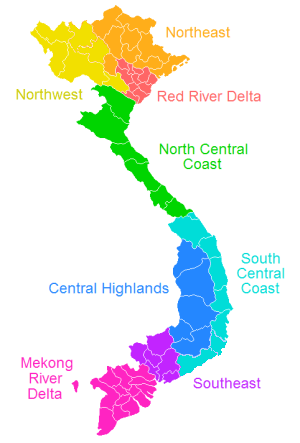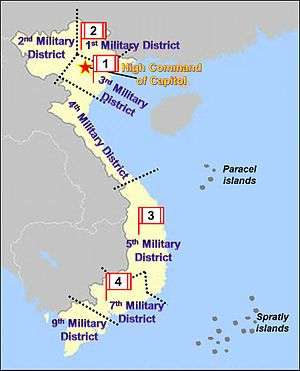Subdivisions of Vietnam
| Administrative Units of Vietnam |
|---|
| First Tier |
|
| Second Tier |
|
| Third Tier |
Administrative Regions

Geographically, Socialist Republic of Vietnam is divided into 3 regions:
- Northern Vietnam
- Central Vietnam
- Southern Vietnam
However, the Vietnamese government often divides it into 8 administrative regions:
- Northeast
- Northwest
- Red River Delta
- North Central Coast
- South Central Coast
- Central Highlands
- Southeast
- Mekong River Delta
| Geographical Region | Administrative Region |
|---|---|
| Northern Vietnam (Bắc Bộ, Miền Bắc) | Northeast (Đông Bắc Bộ) |
| Northwest (Tây Bắc Bộ) | |
| Red River Delta (Đồng Bằng Sông Hồng) | |
| Central Vietnam (Trung Bộ, Miền Trung) | North Central Coast (Bắc Trung Bộ) |
| South Central Coast (Duyên hải Nam Trung Bộ) | |
| Central Highlands (Tây Nguyên) | |
| Southern Vietnam (Nam Bộ, Miền Nam) | Southeast (Đông Nam Bộ, Miền Đông) |
| Mekong River Delta (Đồng Bằng Sông Cửu Long) or Southwest (Tây Nam Bộ, Miền Tây) |
Within each administrative region, they comprises the various First Tier administrative units.
Administrative Units
Officially, Vietnam is divided into 3 administrative tiers, with different types of administrative unit on each tier:
- First Tier: Municipality (thành phố trực thuộc trung ương) and Province (tỉnh)
- Second Tier: Urban District (quận), Provincial City (thành phố trực thuộc tỉnh), Town (thị xã) and Rural District (huyện)
- Third Tier: Ward (phường), Township (thị trấn) and Commune (xã)
A Fourth Tier also exists as Hamlet (xóm, ấp) and Village (làng, thôn, bản). However this is not an official tier.
| Level | 1st | 2nd | 3rd |
|---|---|---|---|
| Type | Municipality (Thành phố trực thuộc trung ương) | Urban District (Quận) | Ward (Phường) |
| Town (Thị xã) |
Ward (Phường) | ||
| Commune (Xã) | |||
| Rural District (Huyện) |
Township (Thị trấn) | ||
| Commune (Xã) | |||
| Province (Tỉnh) |
Provincial City (Thành phố trực thuộc tỉnh) | Ward (Phường) | |
| Commune (Xã) | |||
| Town (Thị xã) | Ward (Phường) | ||
| Commune (Xã) | |||
| Rural District (Huyện) | Township (Thị trấn) | ||
| Commune (Xã) | |||
First Tier
On the First Tier, there are:
- 5 municipalities - Hà Nội, Hải Phòng, Đà Nẵng, Hồ Chí Minh City and Cần Thơ
- 58 provinces - Điện Biên, Hòa Bình, Lai Châu, Lào Cai, Sơn La, Yên Bái, Bắc Giang, Bắc Kạn, Cao Bằng, Hà Giang, Lạng Sơn, Phú Thọ, Quảng Ninh, Thái Nguyên, Tuyên Quang, Bắc Ninh, Hà Nam, Hải Dương, Hưng Yên, Nam Định, Ninh Bình, Thái Bình, Vĩnh Phúc, Hà Tĩnh, Nghệ An, Quảng Bình, Quảng Trị, Thanh Hóa, Thừa Thiên-Huế, Bình Định, Bình Thuận, Khánh Hòa, Ninh Thuận, Phú Yên, Quảng Nam, Quảng Ngãi, Đắk Lắk, Đắk Nông, Gia Lai, Kon Tum, Lâm Đồng, Bà Rịa-Vũng Tàu, Bình Dương, Bình Phước, Đồng Nai, Tây Ninh, An Giang, Bến Tre, Bạc Liêu, Cà Mau, Đồng Tháp, Hậu Giang, Kiên Giang, Long An, Sóc Trăng, Tiền Giang, Trà Vinh and Vĩnh Long
Second Tier
Municipalities are subdivided into Urban District, Town and Rural District. There is no official capital of the municipality but usually the seat of the local authority is located at the central urban district.
Provinces are subdivided into Provincial City, Town and Rural District. Normally, the Provincial City or Town is the capital of that province.
Based on latest sources of General Statistics Office of Vietnam (GSO), there are 713 Second Tier units.[1]
The Rural District can be upgraded to Town, which can be upgraded to Provincial City.
Third Tier
Urban Districts are subdivided into Ward, while Towns are subdivided into Ward and Commune. Rural Districts are subdivided into Township and Commune.
There is no designated capital for Urban District and Rural District, but usually the seat of the local authority is located at the central ward or township. Similarly, there is no designated capital for Provincial City or Town, but usually the seat of the local authority is located at the central ward.
In 2016, GSO indicated that there are 11,162 Third Tier units with 1,581 wards, 603 townships and 8,978 communes.[1]
Townships are known as thị trấn in Vietnamese, but less common type of townships are farm townships (thị trấn nông trường). [2]
The Commune can be upgraded to Township or Ward.
Other Subdivisions
Vietnam is also divided into electoral divisions and military regions.
Electoral divisions
For electoral purpose, each province or municipality is divided into electoral units (đơn vị bầu cử) which are further divided into voting zones (khu vự bỏ phiếu). The number of electoral divisions varies from election to election and depends on the population of that province or municipality.
Since the parliamentary election in 2011, there are 183 electoral units and 89,960 voting zones.
Military regions

Vietnam People's Army is organised into 8 military regions:
- High Command of Capital Hanoi (Bộ Tư lệnh Thủ đô Hà Nội) in Ha Noi
- 1st Military Region (Vietnam People's Army) (Quân khu 1) in Northeast
- 2nd Military Region (Vietnam People's Army) (Quân khu 2) in Northwest
- 3rd Military Region (Vietnam People's Army) (Quân khu 3) in Red River Delta
- 4th Military Region (Vietnam People's Army) (Quân khu 4) in North Central Coast
- 5th Military Region (Vietnam People's Army) (Quân khu 5) in South Central Coast and Central Highland
- 7th Military Region (Vietnam People's Army) (Quân khu 7) in Southeast
- 9th Military Region (Vietnam People's Army) (Quân khu 9) in Mekong Delta